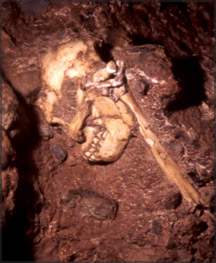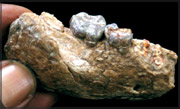|
DAILY NEWS ONLINE |
|
|
|
OTHER EDITIONS |
|
|
|
|
|
|
|
|
|
OTHER LINKS |
|
|
|
|
|
|
  |
|
Getting closer to knowing our ancestors
|
|
|
Popularly referred to as "Lucy and her kind", these hominids are thought to have been the progenitors of our genus, Homo.
They were all bipedal creatures with thick jaws, large molars and small incisors - radically different from the apes further back in the family tree.
It was not until the 1990s that further fossil discoveries were made to extend the hominid record to 4 million years.
This happened when Meave Leakey of the National Museums of Kenya discovered A. anamensis with slightly more archaic characteristics than Lucy.
About the same time, Tim White of the University of California, Berkeley, described an even order collection of hominid fossils as Ardipethecus ramidus ramidus dating back to 4.4 million years.
More recent finds pushed the evolutionary clock back still further. Berkely graduate student Yohannes Haile-Selassie announced the discovery of 5.2 to 5.8 million old hominid fossils in Ethiopia's Middle Awash region.
|
|
These fossils have been classified as a sub-species of Ardipithecus ramidus, namely Ardipithecus ramidus kadabba.
Martin Pickford and Brigitte Senut of the National Museum of Natural History in Paris, working in Tugen Hills in Ethiopia discovered the Orrorin tugenensis fossils dated to 6 million years.
Central Africa
The palaeontologist community, still digesting the implications of the above fossil finds, were confronted in July 2002 with the report of Michael Brunet of the University of Poitiers, Paris that he had unearthed a nearly 7 million old fractured hominid skull in the Djurab Desert at Torres Menella in northern Chad.
In his opinion it was the visage of the long lost relative he had been searching for over 26 years. He called it Sahelanthropus tchadensis, nicknamed Toumi, which means 'hope of life' in the local Goran language.
Brunet considered it the oldest hominid and the earliest member of human lineage.
The A. ramidus kadabba, Orrorin and Sahelanthropus finding have not gone unchallenged, even though they contain a mosaic of primitive and advanced features to suggest a close relationship to the last common ancestor.
Investigators agree that these bones of contention need more fossil finds to elucidate how they are related to one another and ourselves.
In the present context they may therefore be treated as 'older snapshots of Ardipithecus lineage', with Sahelanthropus being the oldest hominid and Orrorin its lineal descendants.
|
|



